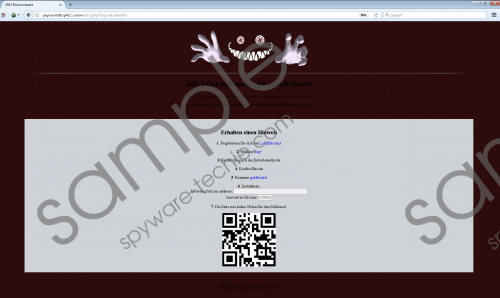Do you know what 3301 Ransomware is?
Researchers believe 3301 Ransomware is a new variation of a previously encountered malicious application called Karmen Ransomware. It looks like the malware was improved as it works a bit differently from its previous version. Of course, the main threat’s task is still to take its victim’s files for hostages by encrypting them with a secure cryptosystem. Therefore, if you encounter this malicious application, all of your personal data could be lost. In order to get to know more about 3301 Ransomware, we would advise you to read the rest of our report. However, if you would like to get rid of this malware as soon as possible, you can slide below the text and try to erase it manually while following the provided removal guide.
The previous version of 3301 Ransomware was distributed through Spam emails and dangerous file-sharing web pages, so it is quite possible this newest variant will be spread through similar channels as well. Meaning, to avoid this ransomware or infections alike you should stay away from untrustworthy file-sharing web pages and try to be more cautious with email attachments received from unknown sources. We do not say it is a simple task to identify potentially harmful files, but it might be easier to protect the system if you acquire a reputable antimalware tool. It can warn users about threats itself, but for extra precautions, it would be safer to use the antimalware tool to scan suspicious files before opening them. This way you might learn whether the scanned data is malicious or not before even launching it.
3301 Ransomware was programmed to mark all its encrypted files with .3301 extension, so the data that gets locked should have this particular second extension at the end, for example, picture.jpg.3301, text.docx.3301, etc. Also, there is more, as the malicious application should change user’s Desktop image, place numerous ransom note’s (DECRYPT_MY_FILES.HTML) copies in every directory containing encrypted data, and even possibly launch a text to speech file called DECRYPT_MY_FILES.vbs so the user would hear the malware’s message through his headphones or speakers. All of these mentioned files should be placed soon after the encryption process is ended and not before it since it is important for the infection to hide until the encryption is finished. Otherwise, it is possible the user could interrupt the process, for example, by shutting down the computer. 3301 Ransomware screenshot
3301 Ransomware screenshot
Scroll down for full removal instructions
The ransom note, Desktop image, and the text to speech files all repeat almost the same message. In short, it claims 3301 Ransomware encrypted all user’s files, and if the victim wants to get them back, he has to pay a ransom. The hackers give seven days to make the payments, after that they threaten to erase the promised unique decryption key from their secret server. We do not think it would be smart to put up with any demands even if the asked sum is small. First of all, there are no guarantees the malicious application’s creators have the means to help you and even if they do they may not bother to provide these means. Second of all, they could try to extort more money from you by asking to pay once again.
All things considered, we believe the best option is to ignore the demands and erase 3301 Ransomware at once. The removal guide users can find below this text will show them how they could locate data belonging to the malicious application on their own and delete it manually. Nevertheless, the task might still be too complicated for some of you, and this is why we also encourage our readers to use a legitimate antimalware tool. Just install the tool, and soon you should be able to perform a full system scan and get rid of all identified threats at the same time.
Eliminate 3301 Ransomware
- Press Ctrl+Alt+Delete.
- Go to the Task Manager.
- Kill suspicious randomly named processes that could belong to the malware by clicking the End Task button.
- Leave Task Manager and tap Windows Key+E.
- Check your Desktop, Temporary Files, and Downloads folders.
- Look for malicious recently downloaded files that may have got the system infected.
- Right-click these files and press Delete.
- Find the %APPDATA% folder.
- Look for a suspicious file named iekaewe.exe or similarly, right-click it and select Delete.
- Close the File Explorer.
- Empty the Recycle bin.
- Reboot the system.
In non-techie terms:
3301 Ransomware is a tool to extort money from unfortunate users who accidentally infect their system with this threat. The malicious application encrypts data to make it unreadable so you could no longer access it. Then it should show a ransom note in which the malware’s creators promise to send a decryption tool so the user could unlock all damaged files, but in return they want him to pay a ransom. The bad news is you have to pay first, which means the hackers can take the money you transfer without sending you the decryption tools. This is why we would advise our readers not to waste their savings and eliminate the infection with the removal guide placed above or a reputable antimalware tool of their preference. Later, you could restore files if you have any copies of them somewhere safe or you may try various recovery tools.
